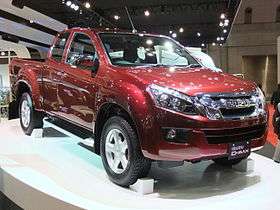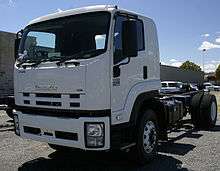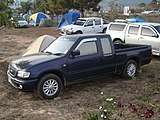Isuzu Philippines
Isuzu Philippines Corporation (IPC) is a subsidiary of the Japanese commercial vehicle manufacturer Isuzu Motors and headquartered in Biñan, Laguna, Philippines. The company was formed on August 7, 1995 with an investment of ₱1,000,000.000s. The company operates as a joint venture with Mitsubishi Motors Philippines, with each holding 35%. Other shareholders, with a share of 30%, include the Ayala Corporation and the Rizal Commercial Banking Corporation. The company's current president is Hajime Koso, replacing Nobuo Izumina.
| Subsidiary | |
| Industry | Manufacturing |
| Founded | August 7, 1995 |
| Headquarters | 114 Technology Avenue, Phase 2, Laguna Technopark, Biñan, Laguna 4024 |
Key people | Hajime Koso (President) Shojiro Sakoda(Executive Vice President) |
| Products | Commercial vehicles, trucks and bus chassis |
| Owner | Isuzu Motors Limited (35%), Mitsubishi Corporation (35%), Ayala Corporation (15%), Rizal Commercial Banking Corp. (15%) |
| Website | www |
History
Isuzu's Philippine debut came in the 1950s through its line of trucks. In 1972, General Motors and Isuzu formed a joint venture during the 1970s to create GM Philippines. More changes in management took place in the two decades that followed, leading to the creation of Isuzu Motors Pilipinas in 1989 as a subsidiary of Isuzu Motors Ltd. To pave the way for a new joint venture, the company ceased its operations in 1995. On August 7, 1995, Isuzu Philippines Corporation was formed. The company’s manufacturing facilities is located on industrial land located at the Laguna Technopark in Biñan, Laguna. Isuzu Philippines Corporation annually produces 8,000 to 15,000 vehicles. Directly adjacent to the plant are the works of Isuzu Autoparts Manufacturing Corporation, which produces transmissions.
In 1996, production began with the Hilander, the N-Series and the Forward. These models still dominate the model range in revised form. In 1997, the Fuego was introduced and became very popular. A year later came the Trooper. In late 2003 the D-Max was unveiled, and in 2005 followed its sport utility vehicle variant, the Alterra. As a production model, however, in 2007 the company offered the Isuzu NHR-PV. It is a 17-seater bus, which is built on the N-Series' chassis. On 18 September 2013, Isuzu debuted the second-generation D-Max, almost exactly ten years after the unveiling of the original in November 2003. The D-Max is to be built at Isuzu's Laguna plant, but will be imported from the main factory in Thailand first.[1]
Current models
 Isuzu D-Max
Isuzu D-Max
2013-present_01.jpg) Isuzu MU-X
Isuzu MU-X
2014-present Isuzu N-Series
Isuzu N-Series
2004-present Isuzu Forward
Isuzu Forward
2007-present
Models
 Isuzu HiLander
Isuzu HiLander
1996 - 2001- Isuzu Crosswind
2001-2017 - Isuzu N-Series
1996 - 2004 - Isuzu Forward
1996 - 2007  Isuzu Fuego
Isuzu Fuego
1997 - 2004_(front)%2C_Serdang.jpg) Isuzu Trooper
Isuzu Trooper
1998 - 2005_(front)%2C_Serdang.jpg) Isuzu D-Max
Isuzu D-Max
2003 - 2008 Isuzu Alterra
Isuzu Alterra
2005 - 2014 Isuzu D-Max
Isuzu D-Max
2008 - 2013
Buses
• PABFVR34P
• PABFTR33P
• LV123
• LV423
Mini Bus
• NQR
References
- Tadeo, Patrick Everett (2013-09-18). "Isuzu PH commences assembly of new D-Max at Laguna plant". TopGear.com.ph. Summit Media.